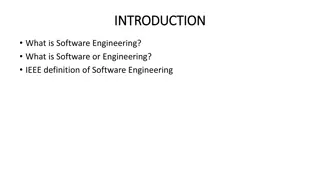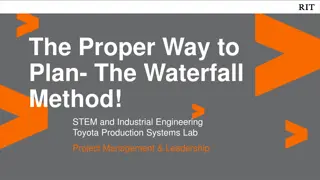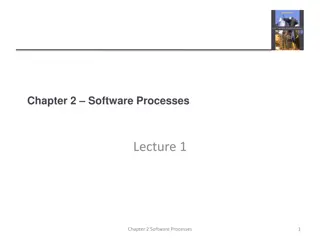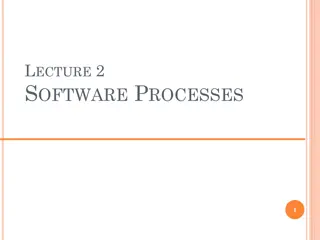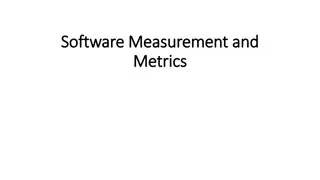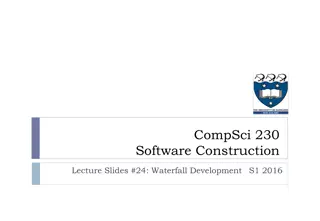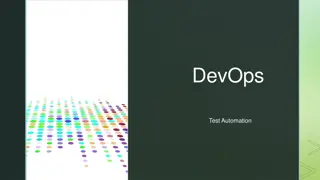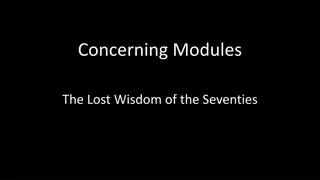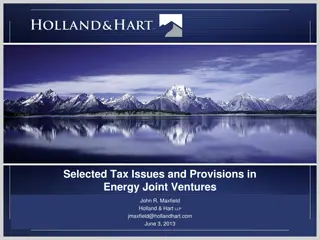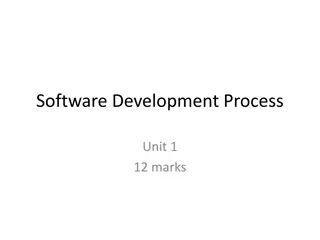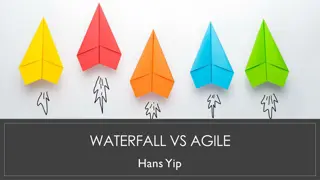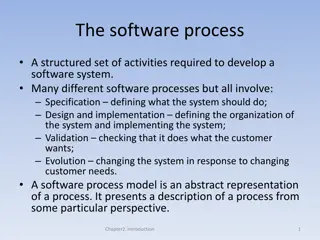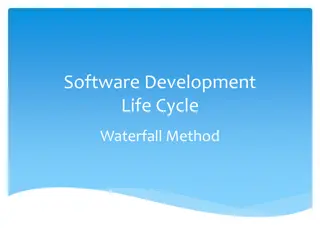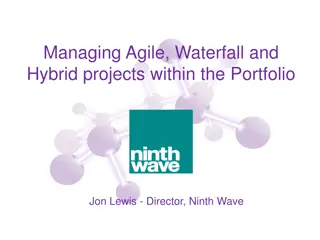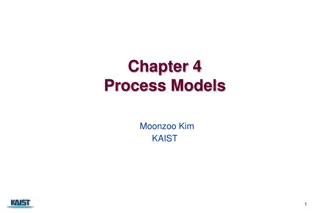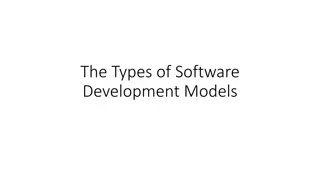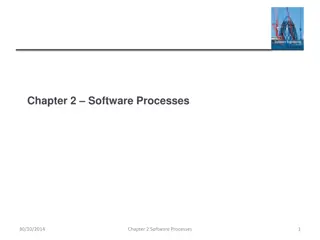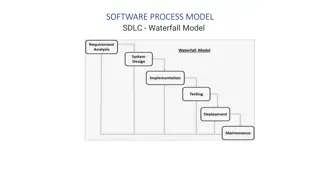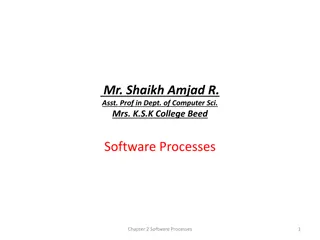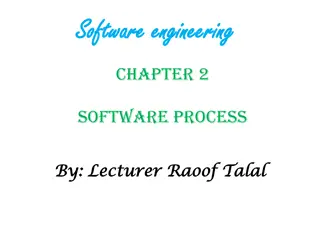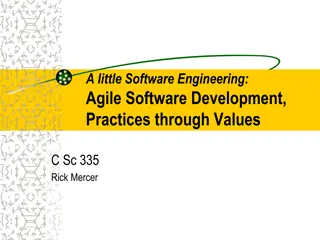Overview of Waterfall Model in Software Quality
Understanding the traditional approach to testing in software development, the Waterfall model involves staged development with each stage signed off before the next begins. Verification is crucial at each stage to ensure the product is being built correctly.
Download Presentation

Please find below an Image/Link to download the presentation.
The content on the website is provided AS IS for your information and personal use only. It may not be sold, licensed, or shared on other websites without obtaining consent from the author.If you encounter any issues during the download, it is possible that the publisher has removed the file from their server.
You are allowed to download the files provided on this website for personal or commercial use, subject to the condition that they are used lawfully. All files are the property of their respective owners.
The content on the website is provided AS IS for your information and personal use only. It may not be sold, licensed, or shared on other websites without obtaining consent from the author.
E N D
Presentation Transcript
CompSci 230 Software Design and Construction Software Quality 2015S1 Traditional approach to testing (Waterfall)
Lecture plan Week 1: No class -Anzac Day What is software quality? Some key developer practices (version control, testing). Week 2: Black box testing. White-box testing. Myers' testing principles. Week 3: Traditional approach to testing (Waterfall). Agile approach to testing (XP). Famous failures. 2 Software Quality 2015 S1
Learning goals Have a working understanding of : the waterfall model for software development testing in the waterfall model iterative, incremental and evolutionary development Discuss: limitations of the waterfall model agile alliance and manifesto 3 Software Quality 2015 S1
Brief history of waterfall 1960s : programming is an art practitioners receive no formal training serious concerns about quality as projects became larger 1968 : conference organised by the NATO Science Committee discussed issues with software manufacture coined the term software engineering introduced standard development model (waterfall) based on staged manufacturing process Note : many current issues discussed (need to iterate, obtain feedback from customer, reuse, product architecture) BUT appears to have been little attempt to reframe software development as anything other than a manufacturing process. 4 Software Quality 2015 S1
Waterfall model Staged model. Each stage : implemented by different people with different skill sets must be completed and signed off before the next begins verified against the previous stage before sign-off http://www.coleyconsulting.co.uk/from-waterfall-to-v-model.htm 5 Software Quality 2015 S1
Waterfall model - verification At each stage, what is needed to verify that the product is being built according to what is stated in the previous stage (Are we building the product right)? Documents requirements specs, design specs, code, test cases Process reviews, walkthroughs, inspections http://softwaretestingfundamentals.com/verification-vs-validation/ 6 Software Quality 2015 S1
Waterfall model - documents Documents play a critical role in the verification process. Document standards : IEEE Recommended Practice for Software Requirements Specifications (SRS) etc. IEEE Std 830-1998 - IEEE Recommended Practice for Software Requirements Specifications Software Quality / 7 2015 S1
Waterfall model - requirements A template from the IEEE SRS. Note that, in addition to the features, you must consider external product interfaces and non-functional requirements. IEEE Std 830-1998 - IEEE Recommended Practice for Software Requirements Specifications Software Quality / 8 2015 S1
V-model for testing Staged model testing : Each stage has a corresponding kind of test AKA Integration test AKA Unit test http://www.coleyconsulting.co.uk/from-waterfall-to-v-model.htm 9 Software Quality 2015 S1
V-model for testing Component (unit) test Does the component implement the design? Performed by developer OR independent tester Issues Cannot catch every bug in a component. Impossible to test every combination of inputs (black box) every execution path (white box) 10 Software Quality 2015 S1
V-model for testing Interface (integration) test Do the components work with each other? Performed by developer OR independent build person Issues Many integration issues for large application interfaces misunderstanding about functionality 11 Software Quality 2015 S1
V-model for testing System test Does the software deliver to the specification (functional and non- functional requirements)? Performed by specialised test team Issues Can be difficult to replicate user s (production) environment 12 Software Quality 2015 S1
V-model for testing Acceptance test Does the software deliver what the customer wanted? Performed by specialised QA team and/or customer (alpha releases) Issues Can be difficult to replicate user s environment use low spec machines to test e.g. latency issues 13 Software Quality 2015 S1
V-model for testing Release test Does the software work in the existing business environment? Performed by operations team and/or customer (beta releases) Issues Customers can be busy and don t want to be interrupted If beta testing, need committed users 14 Software Quality 2015 S1
V-model for testing System, acceptance and release tests aim to validate that the software does what the customer wants it to do (Did we build the right product?) System test Does the software deliver to the specification? Test team. Acceptance test Does the software deliver what the customer wanted? Customer. Release test Does the software work in the existing business environment? Operations team. http://softwaretestingfundamentals.com/verification-vs-validation/ 15 Software Quality 2015 S1
Quality characteristics Testing relating to quality characteristics: Load testing apply maximum loads to test maximum capacity. Stress testing find breaking point by applying over the maximum load. Usability testing measure how quickly users learn to use the system complete specific tasks etc. Reliability testing Portability testing etc. 16 Software Quality 2015 S1
Other testing Other kinds of testing : Smoke testing. During integration, before the product is handed over to the test team, a superficial check is made by the build person that the product s basic features do what they are supposed to. Purpose is, of course, to not waste the test team s time. Regression testing. Applied when changes to the product are needed (to fix bugs or add functionality) to make sure nothing is broken. Applied at unit, integration and system test levels, 17 Software Quality 2015 S1
Waterfall - issues Practitioners uncovered some serious issues when implementing a waterfall approach : During projects lasting several years, clients often changed their minds about what was required. The wrong product was delivered. changes in environment introduction of new technologies The need for extensive documentation resulted in documents not being kept up- to-date. e.g. during design phase, mistake in requirements document is discovered fixed in design doc but not in requirements doc. No communication between practitioners from different phases meant that tacit knowledge wasn t shared. Coders often didn t really grasp what was wanted. 18 Software Quality 2015 S1
Waterfall summary Waterfall is a staged approach based on a manufacturing paradigm. Created to address problems in large, complex development efforts. Communication is largely via documentation. Serious issues relating to documentation, communication and delivering what the customer really wanted. 19 Software Quality 2015 S1
Agile alliance Many practitioners explored ways to mitigate issues Many (most?) projects actually implemented an iterative and incremental approach. 1970s: Harlan Mills - upfront specification, deliver in many increments. adapt designs as a result of customer feedback. 1976: Tom Gilb formally introduced ideas of evolutionary project management . no upfront specification, rather discover requirements in an iterative way. In 2001, a number of separate groups working on agile approaches to software development formed the Agile Alliance. http://www.craiglarman.com/wiki/downloads/misc/history-of-iterative-larman-and-basili-ieee-computer.pdf http://www.agilealliance.org/ 20 2015 S1 Software Quality
Agile alliance Mission We support those who explore and apply Agile principles and practices to make the software industry productive, humane and sustainable. Manifesto We are uncovering better ways of developing software by doing it and helping others do it. Through this work we have come to value: Individuals and interactions over processes and tools Working software over comprehensive documentation Customer collaboration over contract negotiation Responding to change over following a plan. That is, while there is value in the items on the right, we value the items on the left more. http://www.craiglarman.com/wiki/downloads/misc/history-of-iterative-larman-and-basili-ieee-computer.pdf http://www.agilealliance.org/ 21 2015 S1 Software Quality
Agile alliance Principles: http://www.agilealliance.org/ 22 2015 S1 Software Quality
Agile methods http://en.wikipedia.org/wiki/Agile_software_development 23 2015 S1 Software Quality
Agile approach Agile approach is based on a software-as-a-service paradigm. Communication is largely face-to-face. Software is delivered frequently to customers. The agile methods are quite different from one another but have the Principles in common. Next session, we will study one agile method, eXtreme Programming (XP), in greater detail. 24 Software Quality 2015 S1


